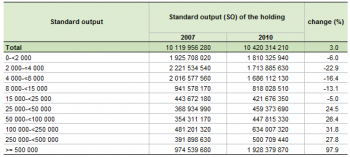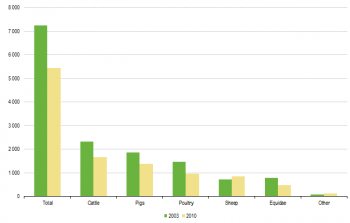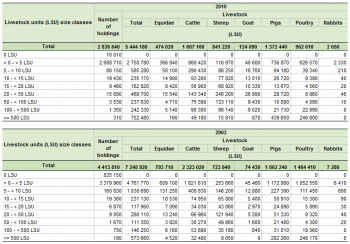Archive:Agricultural census in Romania
- Data from November 2012. Most recent data: Further Eurostat information, Main tables and Database. Due to that the agricultural census is carried out every ten years, the next update of this article will take place in December 2022.
This article is part of a series of country-specific essays on the results of the European Union (EU) Farm structure survey (FSS) 2010. The FSS collects information on the structural characteristics of agricultural holdings (land use, livestock and labour force) and is carried out every 10 years as an Agricultural census by all the EU Member States, with two or three additional, intermediate sample surveys carried out in-between.
In Romania, the Agricultural census 2010 was the second to be fully harmonised with EU regulations and the first to be conducted after the country’s accession to the European Union in 2007. The present analysis of the farm structure includes a comparison with the previous (2002) Agricultural census. Although the reference years of the Agricultural census in Romania were 2002 and 2010 respectively, the common designation is Agricultural census 2003 and 2010.

Source: Eurostat (ef_kvaareg) (ef_ov_kvaa) (demo_pjan) and FSS 2003 and 2010

Source: Eurostat (ef_kvaareg) (ef_ov_kvaa) and FSS 2003 and 2010
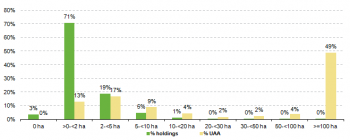
Source: Eurostat (ef_kvaareg) (ef_ov_kvaa)

Source: Eurostat (ef_kvftreg)
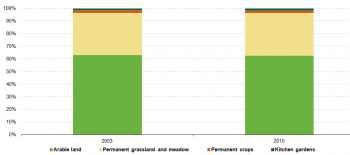
Source: Eurostat (ef_lu_ovcropaa) (ef_oluaareg)
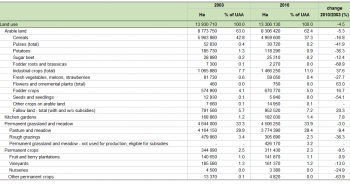
Source: Eurostat (ef_lu_ovcropaa) (ef_oluaareg)

Source: Eurostat (ef_mptenure)

Source: Source: Eurostat (ef_pmhouscatlaa)
Main statistical findings
Key indicators
There were about 3.8 million agricultural holdings in Romania in 2010; a 14% decrease compared with 2003 (- 625 850 farms). This was by far the highest number of farms recorded within the EU-27.
As shown in Table 1, the utilised agricultural area (UAA) was also very large compared to other Member States at 13.3 million hectares, which was a 4.5% decrease compared with 2003. The UAA was similar in Poland (14.4 million ha) and Italy (12.8 million ha). In relative terms, the agricultural area covered 56% of Romanian territory in 2010.
Given that the fall in the number of holdings was sharper than that in the agricultural land, the average area per farm increased slightly from 3.1 hectares per farm in 2003 to 3.4 in 2010. This trend was commonly observed throughout the EU-27, although the increase in average holding size was smaller in Romania than in other Member States.
As there was a very large number of farms in Romania, there were also many agricultural workers; about 7.1 million people were working on Romanian farms in 2010. Between the two reference years, the regular agricultural labour force decreased by 19%; in relative terms, about 1.7 million people stopped working on farms. Nonetheless, the Romanian agricultural labour force represented 73% of the active population[1] in 2010, by far the highest proportion among the EU Member States.
The livestock population, expressed in livestock units (LSU), decreased by 1.8 million LSU (-25%) between the two reference years and stood at 5.4 million LSU in 2010. Among the other EU Member States, Ireland (5.8 million LSU) and Denmark (4.9 million LSU) had similar LSU values.
Regional key indicators
Presenting regional data, Table 2 provides further insight into the structure of Romanian agriculture. The largest number of holdings (800 830) was found in the region of Sud – Muntenia, 21% of the total population of farms in Romania. The Nord-Est territory had a slightly smaller number (790 790), accounting for 20% of the farm population. At the opposite end of the scale, the smallest number of farms (33 490) was in the metropolitan area of Bucuresti – Ilfov, just 0.9% of the country's holdings; in 2003 this proportion was slightly higher (1.6%) with 71 780 holdings within the region.
In terms of the agricultural area, the region of Sud – Muntenia also contained the largest proportion of the country's UAA (18%) in 2010, corresponding to 2.3 million hectares. The territory of Sud-Est had the second largest agricultural area (2.2 million ha) and accounted for 16% of the Romanian UAA, followed by Nord- Est with 1.9 million hectares (15%). As well as containing the lowest number of farms the capital region Bucuresti – Ilfov unsurprisingly had the lowest agricultural area of 62 450 hectares, just 0.5% of Romania's UAA. This was a large decrease of 70% compared with 2003.
According to the FSS 2010, the Nord-Est region was the only one with over a million livestock units (LSU)in 2010 (1.0 million LSU). This represented 18% of the farm animal population; the corresponding proportion (19%) was slightly higher in 2003. The second highest population of livestock in Romania (16%) was in Sud – Muntenia (869 440 LSU). The Sud-Est (800 190 LSU) and the Nord-Vest (769 190 LSU) regions accounted for similar proportions with 15% and 14% respectively.
In 2010 the largest numbers of agricultural workers were working on farms in the regions of Nord-Est and Sud – Mutenia, where the workforces both stood at 1.5 million people and represented about a fifth each of the total number of farm workers.
Agricultural holdings
In 2010, 74% of Romania's farm population had less than 2 hectares of agricultural land, equating to about 2.9 million farms. These smallest holdings covered 13% of the country’s UAA. At the other end of the scale, agricultural holdings with 50 hectares or more of UAA accounted for over half (53%) of the country's agricultural area, although they represented only 0.5% of the number of Romanian farms.
As shown in Figure 1, there were also fairly large numbers of agricultural holdings with 2 to 4.9 hectares of agricultural land, 19% of the total number, covering 2.2 million hectares of UAA (17%) in 2010.
The fragmentation of the structure of the Romanian farms partially derives from the land restitution which took place during the 1990s. This was a slow process and lasted until 2005, changing the structure of Romanian agricultural land with the proportion of privately owned farmland increasing from about 12% in 1989 to 96% in 2002. In particular, the privatisation process led to the parcelling of land into small pieces on the one hand, and the establishment of large commercial enterprises on the other hand (Banski, J.) [2].
See detailed data at NUTS 2 level for 2003 and 2010
Economic size of the farm
As presented in Table 3, the total standard output (SO) of Romanian agricultural holdings was EUR 10 420 million in 2010, a 3.0% increase compared with 2007. Among the other EU Member States, the Netherlands (EUR 18 929 million) and Denmark (EUR 8 490 million) had the closest values of SO.
In Romania, the smallest holdings with an economic size of less than EUR 8 000 had a total standard output of EUR 5 210 million and accounted for half of the SO of the country, despite this being a 15% decrease from 2007. At the other end of the scale, the largest class of farms – holdings with EUR 500 000 or more of SO – had a SO of EUR 1 928 million and accounted for 19% of Romanian standard output. Over the 2007-2010 timeframe, the SO of this class of farms nearly doubled.
Among the different regions, Sud – Muntenia had the highest SO (EUR 1 891 million), corresponding to 18% of Romanian standard output. Sud-Est (EUR 1 740 million) and Nord-Est (EUR 1 701 million) had very similar values and both accounted for about 16% of the country’s standard output in 2010. At the opposite end of the scale, the region of Bucuresti – Ilfov had the lowest proportion (0.9%) of SO and was the only territory not to have a double digit percentage, although this region also had the lowest number of farms.
See detailed data at NUTS 2 level for 2010 and 2007
Agricultural holding by main type of farming
As shown in Figure 2, holdings specialised in a combination of various crops and livestock were the most common; they represented 16% of the total population of farms in 2010. The second most common type of farms were those specialised in general field cropping (15%), followed by poultry farms (11%), various granivores combined (10%) and holdings specialised in mixed, mainly grazing, livestock (10%).
In terms of the economic size the ranking of farm types looks different, as farms specialised in cereals, oilseed and protein crops made up the largest proportion of SO (15%). Mixed livestock (mainly grazing livestock) farms accounted for a similar proportion (14%), followed by holdings dedicated to sheep, goat and other grazing livestock (11%) and farms dedicated to various crops and livestock combined (11%).
See detailed data at NUTS 2 level for 2010
Land use
The Utilised Agricultural Area (UAA) is the total area taken up by arable land, permanent grassland and meadow, permanent crops and kitchen gardens that is used by the holding, regardless of the type of tenure or whether it is used as a part of common land.
Covering about 96% of Romanian agricultural area, arable land and permanent grassland and meadow were its main components in 2010. Although they both decreased from 2003, their proportions in total agricultural land remained fairly stable over the years. Arable land decreased by 5.3% and stood at 8.3 million hectares in 2010, while permanent grassland and meadow decreased by 3.0% to 4.5 million hectares.
See detailed data at NUTS 2 level for 2003 and 2010
Arable land
In 2010, arable land was essentially made up of cereals, industrial crops, fallow land and fodder crops. The area of cereals was 4.9 million hectares, a 17% decrease compared with 2003. In contrast, industrial crops gained about 400 000 hectares (+38%) over the time period and stood at 1.5 million hectares in 2010. Fallow land, which is land that was not seeded during the reference period, covered 952 520 hectares and increased by 20% over the timeframe. Fodder crops took up further 670 770 hectares and saw a smaller rise of 17%.
See detailed data at NUTS 2 level for 2003 and 2010
Permanent grassland
In 2010, permanent grassland and meadow covered 4.5 million hectares, about a third of the total agricultural land area. Pasture and meadow represented the main components of permanent grassland and stood at 3.8 million hectares in 2010, having decreased by 390 000 hectares from 2003. The remaining two components, rough grazing (2.3% of UAA) and permanent grassland and meadow not used for production and eligible for subsidies (3.2%) covered relatively small areas of 305 690 and 426 170 hectares respectively (see Table 4).
See detailed data at NUTS 2 level for 2003 and 2010
Livestock
Statistics on livestock use two different units of measurement: the number of head (number of animals) and the livestock unit (LSU). The latter allows comparison between different types of livestock.
In 2010 there were about 5.4 million LSU in Romania, a 25% decrease compared with 2003 (-1.8 million LSU). Despite the fact they showed a considerable decline (-28%), cattle remained the most common livestock, representing 31% of the entire population of farm animals in 2010 (1.7 million LSU). Pigs were the second most common farm animal, accounting for a quarter of the livestock population (1.4 million LSU), although they decreased by 26% from 2003. Other common livestock types were poultry (18%) and sheep (15%). While poultry experienced a sharp decrease (-34%), sheep actually increased by 16% between the two reference years.
Within the 2003-2010 timeframe, the fall in the number of livestock (-25%) was sharper than that in the Romanian population (-1.4%). As a result, the number of livestock per inhabitant dropped from 0.33 to 0.25. Similarly, the number of holdings with livestock decreased (-36%) more than the total population of farms (-14%). Hence the proportion of livestock farms decreased from 98% in 2003 to 74% in 2010. However, Romania still remained one of the EU-27 countries with highest proportion of farms with livestock.
Similarly to many other European Member States, the decrease in the number of farms with livestock in Romania was not evenly distributed among the size classes of farms. Indeed, it was mostly evident in small sized farms (those with less than 15 LSU), while holdings with 15 LSU or more increased in number. In particular, farms with 50 to 99 LSU had the highest increase, more than doubling from 1 670 farms in 2003 to 3 530 in 2010.
See detailed data at Nuts 2 level for 2010 and 2003
Labour force
In Romania, the regular agricultural labour force decreased by 19% between 2003 and 2010 from about 8.9 million to 7.1 million people (see Table 6). In terms of the annual work unit (AWU), this fall was much sharper (-40%), decreasing from 2.5 million AWU to 1.5 million AWU. However Romania had the second largest regular farm workforce across the EU Member States in 2010, with Poland recording the highest (1.9 million AWU).
The gender split of sole holders changed in Romania, with the proportion of female sole holders increasing from 28% to 33% over the timeframe, though the number of female sole holders remained unchanged at 1.2 million.
See detailed data at NUTS 2 level on holders' age and gender for 2010 and 2003
See detailed data at NUTS 2 level on type of labour force for 2010 and 2003
Management practices
Type of tenure
In Romania, 60% of the agricultural area (8.0 million ha) was owned by the farmers who actually worked that land (see Table 7). A further 3.6 million hectares (27% of UAA) were farmed by tenants, while the remaining 1.6 million hectares (12%) were utilised in partnership by the landlord and the sharecropper under a written or an oral share-farming contract.
Animal housing
Among the EU Member States, Romania had the largest number of holdings with cattle in 2010 – 728 020 farms farming 2.0 million cattle – with Poland having the second largest (514 120 farms with cattle). As shown in Table 9, the majority of these holdings (61%) housed their cattle in the generic “other” category with a total capacity of about 1.6 million cattle. Both in terms of the number of holdings (246 000) and the animal capacity (1.1 million), the second most common type of housing for cattle was that where the animals are tied to their places and the manure is removed mechanically from the building as solid dung.
The total capacity for cattle in housing systems (3.6 million) significantly exceeded the number of cattle (about 2.0 million), suggesting that the housing capacity of the country was not fully exploited; this also explains why the related percentage was more than 100.
Other gainful activities
In 2010, 42 750 Romanian holdings were undertaking activities other than farm work, directly related to the holding and having an economic impact on it. Although these holdings represented only 1.1% of the country’s population of farms, Romania was among the EU Member States with the highest number of farms with other gainful activities.
As shown in Table 9, the highest number of farms with other gainful activities in Romania (9 510) was recorded in Sud – Muntenia, which accounted for about 22% of the entire population of holdings with other gainful activities.
Information on other gainful activities was collected on eleven categories; a holding could have more than one activity. Processing of farm products was by far the most common source of extra income, as this extra activity was undertaken on 25 340 farms in 2010. Furthermore, contractual work was practised by 8 470 holdings, which was mostly agricultural contractual work (7 250 farms).
See detailed data at NUTS 2 level for 2003
Data sources and availability
Methodological notes Romania – Agricultural census 2010
In Romania, the Agricultural Census 2010 was the second to be conducted in compliance with EU legislation and the first to be carried out after the country’s accession to the European Union on 1 January 2007. The FSS 2010 was a joint effort of the National Institute of Statistics, the Ministry of Agriculture and Rural Development and the Ministry of Administration and Interior.
Survey on agricultural production methods (SAPM)
In 2010 a unique survey was carried out together with the Agricultural census, the Survey on agricultural productions methods (SAPM). This survey collected data at regional level needed to establish agri-environmental indicators as indicated in COM final 508/2006 and to evaluate the greening of the Common agricultural policy.
Data were collected according to the specifications listed in Annex V of the above mentioned regulation, namely data on tillage methods, soil conservation, landscape features, animal grazing, animal housing, manure application, manure storage and treatment facilities and irrigation.
In Romania, the SAPM was conducted as an exhaustive survey together with the Agricultural census.
Reference period
In Romania, information on the FSS 2010 was collected as of 1 December 2010. However, data on land use, irrigation, soil conservation, organic farming, grazing, animal housing and manure, agricultural labour force and other gainful activities refer to the crop year 2010 (30 September 2009 – 1 October 2010). Information on landscape figures and rural development measures was collected with reference to the three years prior to 1 December 2010.
Thresholds for agricultural holdings
Both the FSS and the SAPM targeted all farms complying with the EU definition of agricultural holdings, as stated in articles 2 and 3 of Regulation (EC) Number 1166 of the European Parliament and of the Council. Accordingly all single units (both technically and economically) that had a single management at the reference date and undertook agricultural activities, either as a main or as a secondary activity, were targeted provided they had more than 0.15 hectares of utilised agricultural area or they farmed certain livestock (cattle, swine, sheep or goat) or they had more than 10 poultry.
Common land
Common land is the land that does not directly belong to any agricultural holding but on which common rights apply. It can consist of pasture, horticultural or other land. The treatment of the common land used by an agricultural holding might differ from country to country.
In Romania, common land is pasture and meadow that is administered by local councils. In 2010, it covered about 1.5 million hectares and was exploited by 2 651 special holdings identified separately to avoid double counting.
Geo-reference of the holding
In Romania, the location of the agricultural holdings was obtained by merging information from the database of the Territorial Administrative Units centroids and data from the Agricultural Census 2010.
Economic size
From FSS 2007 onwards, the Standard output (SO), a new classification of the economic size of the holding, is used. The SO has replaced the Standard gross margin (SGM) used before. Nonetheless, for comparability reasons, in FSS 2007 both classifications are available.
Context
European Commission Rural development policy aims to improve competitiveness in agriculture and forestry, the environment and the countryside, as well as to improve the quality of life in rural areas, and to encourage the diversification of rural economies.
As agriculture has been modernised and the importance of industry and services within the economy has increased, agriculture has become much less important as a source of jobs. Consequently, increasing emphasis is placed on the role farmers can play in rural development, including forestry, biodiversity and the diversification of the rural economy, in order to create alternative jobs and provide environmental protection in rural areas.
The FSS continues to adapt in order to provide timely and relevant data to help analyse and follow these developments.
See also
- Agricultural census 2010
- All articles on Romania
- All farm structure articles by country (2007)
- Farm structure statistics
Further Eurostat information
Publications
- Agriculture, fishery and forestry statistics — Main results – 2010-11 - 2012 edition
- Farm Structure Survey in Romania - 2007 - Issue number 80/2009
- Farm Structure in Romania - 2005 - Issue number 60/2007
- Structure of Agricultural Holdings - Romania 2002 - Statistics in focus 41/2005
Main tables
- Agriculture, see:
- Farm structure: historical data (1990-2007) (t_ef)
Database
- Agriculture, see:
- Farm structure (ef)
Dedicated section
Methodology / Metadata
- Farm structure (ESMS metadata file — ef_esms)
- [hthttp://ec.europa.eu/eurostat/documents/749240/749313/RO_NMR_FSS_2010.pdf/fd24fb92-c80d-46fb-92bd-3ec98b8bb69a Methodological Report - FSS 2010 Romania]
- Methodological Report - FSS 2007 Romania
Source data for tables and figures (MS Excel)
Other information
- Regulation 1166/2008 of 19 November 2008 on farm structure surveys and the survey on agricultural production methods and repealing Council Regulation 571/88
- Regulation 1200/2009 of 30 November 2009 implementing Regulation 1166/2008 on farm structure surveys and the survey on agricultural production methods, as regards livestock unit coefficients and definitions of the characteristics
External links
Notes
- ↑ A value calculated over the active population in the 4th quarter 2010 of the EU Labour force survey (LFS) Population, activity and inactivity - quarterly data
- ↑ Jerzy Banski, Agriculture of central Europe in the period of economic transformation
